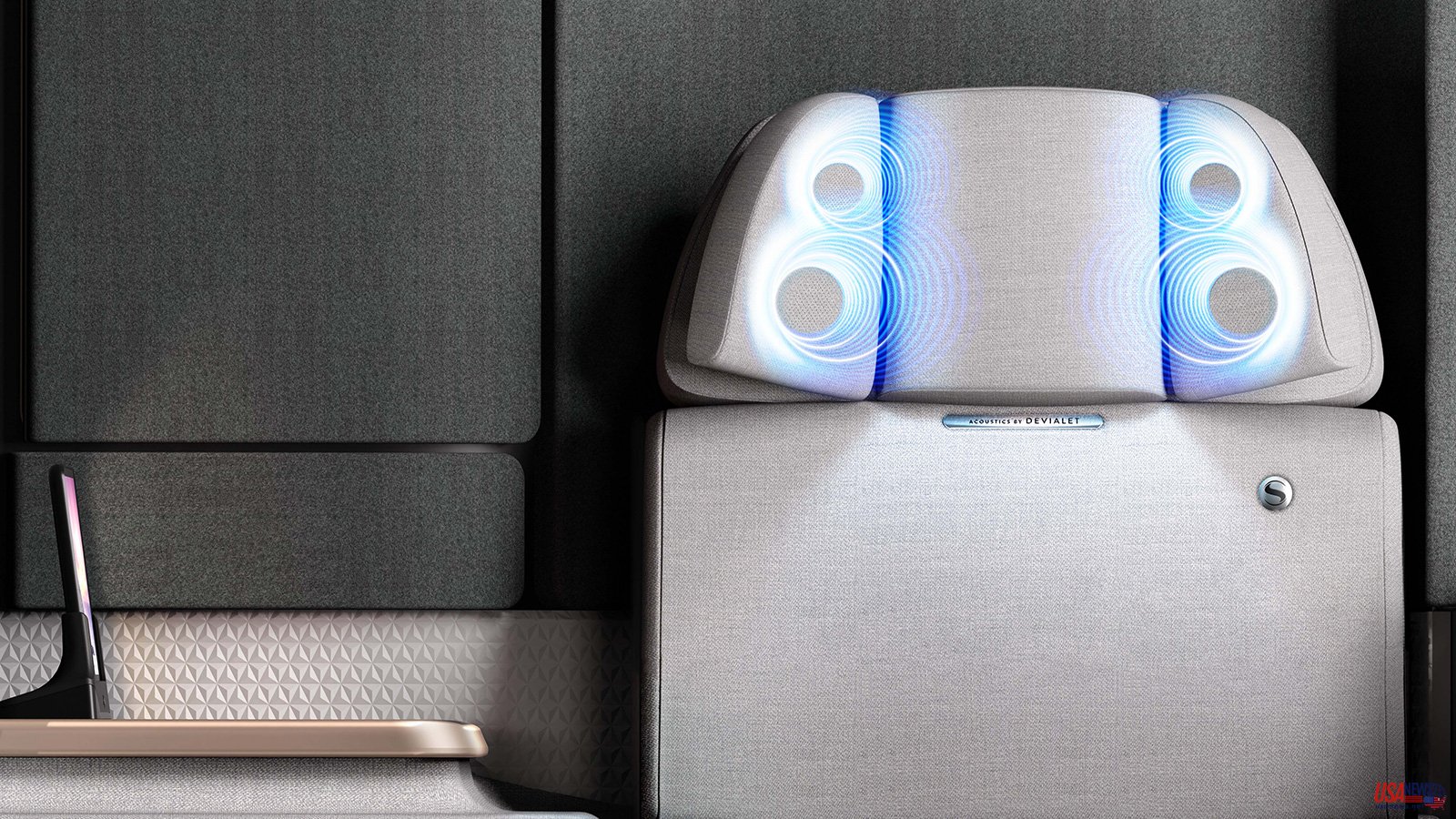Wireless headphones are becoming more ubiquitous, so standard airline headphones with their tangled cables or multi-pronged plugs become less relevant.
You can connect your personal headphones to some aircraft inflight entertainment systems. But will the batteries last long enough? And are you willing to lose your valuable earbuds in the seat mechanism and never see them again?
Enter Euphony is a new concept for airplane seats by French interior designer Safran Sisss. It was created in collaboration with Devialet, an audio technology company.
Euphony eliminates the need to have a personal headset. Speakers are placed in the headrest of each seat, with the sound levels adjusted so that passengers can listen to their preferred entertainment without being disturbed or overheard by others.
The concept was presented by Safran at the Aircraft Interiors Expo in Hamburg, Germany. CNN Travel had the opportunity to visit the Euphony "experience area" to see what the future of inflight entertainment could look like.
Set up in a comfortable way
The AIX prototype appears very similar to a business class plane seat. Safran made minor cosmetic adjustments to the design of the headrest.
The difference is evident as soon as the inflight entertainment switches on. The sound blasts out of the headrest and droning out prerecorded sounds from the airplane engine echoing through the experience area.
The screen displays the trailer for "Doctor Strange in a Multiverse of Madness", a recent Marvel movie. The headrest plays a blast of atmospheric music before the system switches to different audio experiences including a podcast.
It can take me some time to position the headrest correctly. For maximum sound quality, it should be as close as possible to your ears.
The personal speakers work great once the setting is right. The background noise of the simulated aircraft engine is now a distant memory and I can focus my attention on what I see and hear.
Although Euphony cannot replace the cocoon-like feeling of noise-canceling headphones in your ears, it is a more comfortable setup and feels like watching a movie on your sofa. This would work well if you're flying with someone and want to interact while you watch a movie together.
It's difficult to tell if there is any sound leakage in the AIX room because there is only one Euphony mockup. The fact that the sound is not properly heard if the headrest isn't next to your ears suggests that it should be leak-proof. This applies at least in first and business class where passengers are closer together.
While travelers who want privacy or total noise cancellation may still prefer to use their headsets, Paul Wills, a senior architect at Safran, and his team believe Euphony offers more options. Bluetooth can be used to connect personal devices and the headrest speakers will work when the seat has been fully reclined.
Wills' team would prefer that announcements in-flight wouldn't be broadcast from the headrest because they could also be broadcast throughout the cabin.
Instead, announcements by the captain or cabin crew would merely halt inflight entertainment as it is now the norm.
Complex design process
Euphony is in development for several years. Wills and his team claim that the concept was perfected through trial and collaboration.
Wills claims that the sound quality of the speakers in the headrest was poor when Safran tried it out before Devialet arrived.
He says, "At that point, it was evident that we were good seat designers, however, we are not sound designers, so that was why we had to find someone else."
Devialet CEO Franck Lebouchard says that the project was a "thrilling challenge" for his team of audio professionals.
CNN Travel's Lebouchard explains that an aircraft has the most complex sound environment. It is composed of frequencies (low frequencies, high frequencies) and volume.
It was difficult to simultaneously block out both low- and high-frequency sounds from an airplane at the same time. This is why the Euphony team developed noise cancellation technology without noise cancellation technology. The designers wanted to avoid accidentally increasing one frequency while blocking out another.
Devialet and Safran say that Euphony's current version will mask cabin noise and that future iterations will improve the sound mix.
Another challenge was to ensure the highest sound quality, while keeping the aircraft light. Airliner crews are constantly trying to minimize unnecessary weight, both to reduce carbon emissions and to save money.
Euphony's final product adds an additional kilo to any existing seat. This is partly why Euphony is both a business and a first-class offering at the moment.
Wills explains that "it may not be appropriate at this moment in economy, simply and simply because it weights too much,"
The team believes they can refine the concept to make cabins that are more affordable in the future.
Wills says, "There is a clear need for it."
Safran has an unnamed partner launch airline that will debut the product in their first and business class cabins. The Euphony test flights are scheduled for the end of 2018.
Wills says that the ultimate goal is to make flying "normal", replicating the feeling of relaxing at home.
You don't take your headphones off and put on a movie when you get home. Talking to your partner or friends is not the same as shouting at your dog. You should be able to move around. This was the idea behind it. It's like sitting down at home. You turn on the TV and watch a movie.













